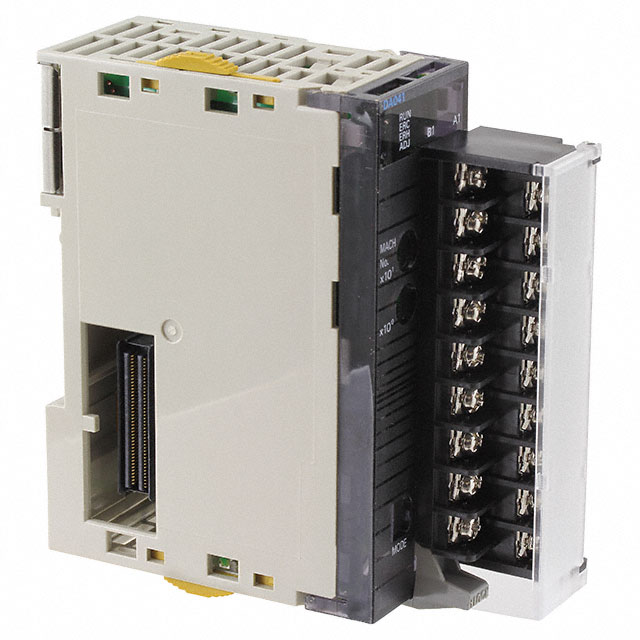
Sysmac CQM1 vs Sysmac CJ Series PLCs
Programmable Logic Controllers (PLCs) play a pivotal role in the design and deployment of customized industrial automation solutions. These controllers interpret text-based or graphical instructions to perform time-sensitive control tasks from basic fan control to complex, multi-tiered automation systems.
When selecting a suitable PLC for your application, Omron's Sysmac platform presents a compelling choice. It offers a fully integrated automation solution with the Machine Automation Controller (MAC) at its core. This controller streamlines system architecture, reduces programming complexity, and boosts productivity. Beyond logic and motion control, MAC integrates safety, robotics, visualization, networking, and data management all embedded with EtherCAT and EtherNet/IP for seamless connectivity.
Among the various models in the Sysmac family, this guide compares two prominent series: the Sysmac CQM1 and the Sysmac CJ Series PLCs.
Overview
Omron Sysmac CJ Series CJ1W-AD041-V1
While the CQM1 series shares some architectural similarities with the CJ series, the latter offers faster speeds, higher capacity, and broader functionality. Notably, CJ series PLCs lack inner board or screw-mounting options found in the CQM1H series. Additionally, CQM1 PLCs allow for more customized modules, including advanced functionalities, specialized I/Os, and communication modules.
CJ series PLCs use task-based programming for fast instruction processing, dynamic I/O memory allocation, and efficient messaging capabilities. DIN track mounting is standard. Most CQM1 CPUs include an RS-232C port for device communication, though only the CPU11-E includes it by default.
CJ series PLCs support open networks like DeviceNet and protocol macros for seamless Ethernet, Controller Link, and DeviceNet communication. Meanwhile, CQM1 PLCs support current and future I/O and specialized modules with broader customization.
Capacity
-
CJ Series: Up to 250k program steps, 256k words of DM memory, 2,560 I/O points
-
CQM1 Series: Up to 15.2k program steps, DM memory ranges from 1k to 6k words, 512 I/O points with 16 built-in DC inputs
I/O Expansion Units
-
CJ Series: Supports 1 to 10 I/O control units on a single CPU rack; up to 3 I/O expansion racks
-
CQM1 Series: Supports up to 16 I/O modules with 0 to 11 used for core expansion/control interfaces
Advanced Features
-
CQM1 CPU: 16 input ports (versus 4 in CJ CPU units)
-
CJ Series: Enhanced performance, pre-installed timers, high-speed counters
-
CQM1 Series: Advanced instruction set including PID, Floating Point Math, Protocol Macro Instructions
CJ series units may include serial option boards and feature replacement selectors and adapter support for legacy I/O cables. Robust networks make the CQM1 particularly versatile.
Programming Steps
For both series:
-
Design I/O device table
-
Allocate work bits
-
Draft ladder diagram
-
Enter mnemonic code
-
Debug and correct errors
-
Execute and fine-tune
Interrupt Handling
-
CJ Series: 32 cyclic and 256 interrupt tasks, including power-off, scheduled, I/O, and external interrupts
-
CQM1 Series: Input, Scheduled, and High-Speed Counter Interrupts
Ladder Diagrams
-
CQM1: No internal I/O table; programming uses SYSMAC-CPT
-
CJ Series: Memory card operations, file handling, and protocol macros enabled
Debugging Tools
-
CQM1: Uses LSS software with Force Set/Reset for diagnostics
-
CJ Series: Trace Memory Sampling (TRSM) for efficient debugging
EC Directive Compliance
Both series comply with EC Directives and must be panel mounted with reinforced or double insulation. They meet EN50081-2 and EN 61000-6-4 standards. Proper installation and surge suppression are vital to ensure compliance.
Pulse I/O Modules
-
CJ Series: Uses add-on Pulse I/O modules ( CJ2M-MD211/212)
-
CQM1 Series: Built-in ports (CN1 and CN2) support up to 50kHz pulses
Normal I/O Modules
-
CJ Series: CIO-based input/output memory allocation
-
CQM1 Series: Terminal Block and Connector Type Units (e.g., CQM1-OD213)
CQM1 offers convenient single-command I/O instructions:
-
TEN KEY INPUT
-
HEXADECIMAL KEY INPUT
-
DIGITAL SWITCH
-
7-SEGMENT DISPLAY OUTPUT
CJ Series allows output terminals to support PWM, Pulse Outputs, and Origin Searches each terminal assigned one function at a time.
Serial Communications
-
CJ Series: Uses macro protocol functions with retry, timeout, and error checking capabilities
-
CQM1 Series: Supports Host Link, RS-232C, and One-to-One Data Link through Standard System Protocol
Macros
-
CJ Series: Includes SEND/RECV, TXDU/RXDU, and PMCR instructions
-
CQM1 Series: Offers 64-bit input/output macro configurations using designated IR addresses
Conclusion
While the Sysmac CJ Series offers faster performance, higher capacity, and more modern features, the CQM1 Series excels in modular flexibility, built-in features, and instruction versatility. Choosing between them depends on your application’s complexity, scalability requirements, and network communication needs.
For more information, contact PLG Automation:
Email: sales@plgautomation.com
Phone: 800-906-9271
